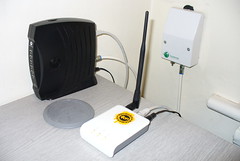Meanwhile, one final piece of the evolving Wi-Fi puzzle is dropping into place
GIVE thanks, for once, to the law of unintended consequences. Too often, it seems, the secondary effects of policy decisions turn out to be at least perverse, if not downright detrimental. But in the case of last week’s Congressional vote to extend America’s emergency payroll tax-cuts, the knock-on effects look like being doubly beneficial.
That is because half the $30 billion cost of extending the emergency measures will be met by auctioning off a bunch of UHF airwaves that were used by local television stations in America to broadcast on channels below 52. Since the switch to all-digital television in 2009, these airwaves are no longer needed by broadcasters, who are to be bribed to hand them back to the government.
The frequencies in play are a highly coveted swathe below 700 megahertz—dubbed the “beachfront properties” of spectrum real-estate. What makes them so desirable is their ability to travel for miles, suffer little interference from foliage and the like, and penetrate into all the nooks and crannies within buildings. The auction for such a huge chunk of spectrum—said to be more than America’s big four wireless carriers currently have between them—should go a long way to overcoming the “spectrum crunch” mobile-phone companies have begun to experience since introducing data-hungry devices like the iPad and other tablet computers.
The auction should offer other benefits as well. Apart from selling off spectrum vacated by broadcasters to mobile carriers, the Federal Communications Commission (FCC) intends to reserve a chunk of television’s old UHF band for unlicensed use by the public. Back in 2008, after years of haggling with the broadcasting industry, the FCC finally voted unanimously to let a new generation of wireless gizmos access the internet using the gaps (“white space”) between television’s UHF channels.
When UHF television was introduced back in the 1950s, empty guard bands were added between each channel to prevent interference from stations broadcasting on adjacent channels. In some places, these white spaces amounted to as much as three-quarters of the bandwidth available for television broadcasting. Even in the busy Los Angeles television market, a third of the spectrum for analogue broadcasting lay idle.
In making white-space frequencies available for public access to the internet, the FCC hopes to spawn a wave of wireless innovation similar to the way Wi-Fi shook up the world of short-range data communications a decade ago. Given the longer range and greater penetrating power of television airwaves (that is why they were chosen for television in the first place), the FCC has taken to calling the proposed technology “Super Wi-Fi” (despite protests from the Wi-Fi Alliance, a trade association based in Austin, Texas, which manages Wi-Fi standards and owns the Wi-Fi trademark).
Be that as it may, what made Wi-Fi such a phenomenal success was the way companies with wireless know-how (many of them start-ups) saw an opportunity to exploit the IEEE 802.11 standard for wireless connectivity in mainly the unlicensed 2.4 gigahertz band used by microwave ovens, cordless phones, baby monitors and garage-door openers. Having seen a $50 billion Wi-Fi industry spring up from practically nothing, the FCC believes fervently that making unlicensed spectrum publicly available is one of the surest ways of spurring innovation.
That may well be so. But many in the wireless industry have reservations over whether Super Wi-Fi (or IEEE 802.22 as it is known technically) can actually deliver the goods as easily and cheaply as the wonks in Washington seem to imagine. Yes, it would allow broadband to be delivered wirelessly like Wi-Fi, but over much greater distances—in theory, up to 60 miles or so, compared with Wi-Fi’s 400 feet. But that does not mean wireless “hotspots” will suddenly expand from covering a few thousand square feet to sprawling over a few thousand square miles. That is never going to happen.
In crowded urban markets, Super Wi-Fi distributed from a single antenna even just 20 miles away would not be able to supply anywhere near enough data capacity to cope with the demand. With Super Wi-Fi’s broadcasting power limited in urban areas for the foreseeable future to 40 milliwatts, to avoid interfering with local television stations, and the same signal being shared by thousands or even millions of city dwellers, download speeds would be glacially slow. The only way to make Super Wi-Fi work in metro areas would be to install antennas a mile or so apart. Even then, download and upload speeds would be no better than clunky old DSL.
Out in the countryside, things would be a lot different. With homes few and far between, Super Wi-Fi would be a cheaper way of delivering broadband (at, say, 1.5 megabits per second download and 384 kilobits per second upload) than either cable or DSL.
Read more . . .
Bookmark this page for “Super Wi-Fi” and check back regularly as these articles update on a very frequent basis. The view is set to “news”. Try clicking on “video” and “2” for more articles.








